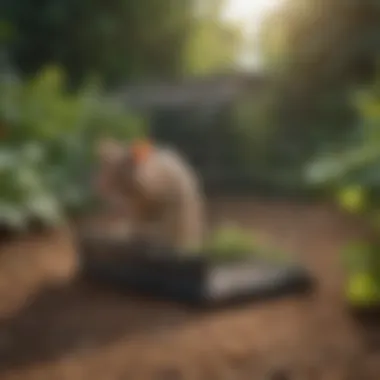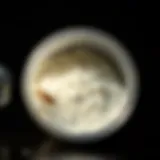Effective Strategies to Keep Rodents Out of Your Yard


Intro
Rodent control is crucial for maintaining a healthy yard and preventing infestations in homes. With rodents such as rats and mice being more than just nuisances, they can lead to serious damage to property and pose health risks. Understanding the traits and behaviors of these pests lays the groundwork for effective prevention strategies.
Understanding Pests
Definition of Pests
Pests are organisms that cause harm to humans, livestock, and crops. In the context of this article, we focus primarily on rodents. Rodents are mammals characterized by their continuously growing incisor teeth. Common examples include Norway rats, house mice, and roof rats. They thrive in various environments and are particularly drawn to places where food and shelter are readily available.
Importance of Pest Identification
Identifying the specific type of rodent present is essential for implementing targeted control strategies. Each species has unique habits, preferred habitats, and diets. For instance, house mice tend to invade homes more than other species, while Norway rats favor underground burrows. Knowing their behavior and preferences aids in taking appropriate measures.
"Understanding the specific rodent species enables a more effective approach to prevention and control strategies."
Prevention Techniques
Home and Garden Preventative Measures
Effective rodent prevention begins at home and in the garden. Here are some key strategies:
- Seal Entry Points: Inspect your property for gaps, holes, and cracks. Use materials like steel wool or caulk to fill these openings, especially around pipes and vents.
- Proper Waste Management: Keep trash cans sealed with tight-fitting lids. Avoid leaving out pet food or fallen fruits and vegetables in the garden.
- Maintain Landscaping: Trim shrubs and bushes. Rodents prefer overgrown areas as hiding spots. Keeping your landscape tidy can discourage nesting.
Seasonal Prevention Tips
Rodent activity may fluctuate with the seasons. Keep these tips in mind:
- Autumn: As temperatures drop, rodents seek shelter indoors. Check and strengthen your home’s defenses before winter.
- Winter: Snow cover can provide insulation for rodents. Keep attics and crawl spaces free of clutter to deter nesting.
- Spring/Summer: Monitor gardens as food becomes abundant. Consider planting herbs that repel rodents, such as mint and sage.
Eco-Friendly Pest Control Solutions
Overview of Sustainable Practices
Opting for eco-friendly pest control not only protects your surroundings but also contributes to a healthier environment. This approach involves minimizing chemical usage and leveraging natural methods.
Natural Remedies and Their Effectiveness
Certain natural solutions can deter rodents effectively. Consider:
- Peppermint Oil: Rodents dislike the scent. Spraying diluted peppermint oil around potential entry points can act as a deterrent.
- Essential Oils: Besides peppermint, oils like eucalyptus and citronella can be equally effective.
- Homemade Traps: Use simple traps made from common household items that do not cause harm to the pest, ensuring a humane approach to control.
Regular monitoring and adjusting prevention techniques can significantly reduce rodent populations in your yard. By understanding their behavior and applying these strategies, you can create an environment that is less inviting to these unwanted guests.
Understanding Rodent Behavior
Understanding rodent behavior is critical when it comes to preventing infestations in your yard. Knowledge of their habits allows homeowners to create environments that are less appealing to these pests. Rodents are not just random intruders; they have specific preferences for food, shelter, and nesting sites. By recognizing these patterns, you can effectively minimize potential risks.
The benefits of understanding rodent behavior extend beyond mere prevention. It aids in early detection and intervention. When you know how rodents behave, you can identify vulnerabilities in your yard that need attention. Additionally, this knowledge allows you to implement targeted strategies that are more effective than general approaches.
Common Types of Rodents
In residential areas, the most common rodents include the house mouse, Norway rat, and roof rat. Each type has distinct behaviors and preferences:
- House Mouse: Often found in homes, these small creatures usually inhabit walls or attics. They prefer grains, seeds, and fruits.
- Norway Rat: Known to dwell underground or in burrows, they have robust bodies and require access to water. They eat a wide variety of foods and are less shy than house mice.
- Roof Rat: These agile climbers typically reside in trees or rooftops. They favor fruits and nuts and are known for their stealthiness.
Recognizing these types and their tendencies can help in tailoring strategies to keep them out.
Feeding and Nesting Habits


Rodents are opportunistic feeders. Their diet mainly consists of grains, fruits, vegetables, or anything accessible. Observing what they eat can reveal their presence in your yard. For example, a sudden depletion of your garden's vegetables might indicate an infestation.
As for nesting, rodents usually choose sheltered spots like dense foliage, debris piles, or even attics. Understanding where they prefer to nest can guide you in making adjustments to secure your yard.
- Keep your yard tidy: Regularly clean up debris, leave no food scraps, and maintain proper landscaping.
- Seal food sources: Store pet food in sealed containers and ensure that compost bins are tightly closed.
By implementing these practices, you make your environment unattractive to rodents. You can effectively limit their ability to thrive in your yard.
Assessing Your Yard for Vulnerabilities
Assessing your yard for vulnerabilities is a crucial step in keeping rodents at bay. An environment that lacks proper assessment can easily become a haven for these pests. By identifying and addressing potential entry points and nearby conditions that attract rodents, homeowners can significantly reduce their chances of experiencing infestations. This proactive approach not only protects your property from damage but also enhances the overall health of your outdoor space.
Identifying Entry Points
To prevent rodents from infiltrating your yard, it is necessary to carefully examine your property's boundaries. The first step is to inspect your home’s exterior. Look for gaps, cracks, and holes in walls, foundations, and around windows. Rodents can squeeze through very small openings. Even a space as little as a quarter of an inch can serve as an entry point for smaller rodents like mice. Be thorough, as these openings may not be readily visible at first glance.
- Inspect utility lines and vents: Ensure that areas where pipes or wires enter the home are tightly sealed.
- Check doors and windows: Look for degraded weather stripping that may need replacement.
- Look underneath porches and decks: These areas can often hide nests and offer additional entry points.
By taking simple actions to seal potential points of access, such as using caulk, steel wool, or expandable foam, you can eliminate many of the opportunities rodents may use to invade.
Evaluating Surrounding Environments
The surrounding environment plays a significant role in attracting rodents. Factors such as nearby vegetation and the presence of food sources need consideration. Ensure that your landscaping does not encourage a rodent-friendly habitat.
- Trim vegetation: Keep trees, shrubs, and grass well-trimmed. Overgrown areas provide cover and nesting opportunities, making it easier for rodents to thrive.
- Reduce clutter: Remove piles of leaves, wood, or other debris that can provide shelter.
- Store food properly: If you have pets, make sure their food is stored in airtight containers. Bird feeders should be placed away from your home, as spilled seeds can attract rodents.
"Understanding and evaluating your yard is a critical step in creating a rodent-free environment. By taking these steps, you significantly change the dynamics in favor of humans over pests."
By incorporating these evaluations into your landscaping routine, you can create an inhospitable atmosphere for rodents, thus enhancing your yard's overall integrity.
Physical Barriers Against Rodents
Implementing physical barriers is a crucial step in keeping rodents out of your yard. These barriers not only provide a first line of defense but also create an inhospitable environment for any potential infestations. Rodents are known to seek shelter and food, making yards that are vulnerable ideal for their habitation. By establishing robust barriers, homeowners can significantly reduce their chances of suffering an infestation and ensure the health of their outdoor spaces.
Fencing Options
Fencing is one of the most effective methods to deter rodents. Choosing the right type of fencing can make a big difference. Here are some options:
- Chain-link fencing: Offers visibility and can be buried underground to prevent tunneling.
- Wooden fences: While not completely rodent-proof, ensuring they are maintained and gaps sealed can enhance effectiveness.
- Metal mesh fencing: This is particularly useful, especially if it is reinforced and extends several inches below ground.
When installing fencing, remember to ensure that gaps are minimal. A fence that is too high may not deter smaller rodents, and a fence that has gaps invites them in. Regular inspections and maintenance of fencing can maintain its integrity against any potential damage.
Sealing Cracks and Holes
Another significant step in building barriers is sealing cracks and holes in your home and yard structures. Rodents can enter through surprisingly small openings, often no wider than a pencil. Here are key areas to inspect:
- Foundation cracks: Inspect the base of your home for any visible cracks or gaps and seal them with caulk or appropriate fillers.
- Utility openings: Areas where pipes and cables enter the house might be overlooked. Use steel wool or similar materials to fill any gaps.
- Doors and windows: Ensure that all seals on doors and windows are intact; consider adding door sweeps for added protection.
Regular checks and timely maintenance are essential to prevent mice and other rodents from finding ways into your yard and home.
Using Rodent-Proof Materials
Utilizing rodent-proof materials in your yard can be a game changer. When constructing or maintaining outdoor spaces, choose materials that are less attractive to rodents or are difficult for them to chew through. Here are some examples:
- Metal containers: Use metal bins for trash storage instead of plastic, which rodents can easily chew.
- Concrete: Preferred for building garden beds or bases for structures due to its durability and impenetrability.
- Treated wood: If using wood, ensure it is treated to deter rodents from chewing on it.
Incorporating physical barriers is a fundamental aspect of integrated pest management. Effective barriers not only thwart rodent entry but also contribute to long-term yard health and reduce reliance on chemical controls.
By establishing comprehensive physical barriers, homeowners create an unwelcoming environment for rodents, safeguarding their yard and home effectively.


Natural Deterrents and Traps
Natural deterrents and traps play a crucial role in keeping rodents at bay and managing their populations in home yards. These methods provide an eco-friendly approach that not only controls rodent presence but also minimizes harm to the surrounding environment. Understanding the effectiveness and implementation of these techniques can empower homeowners and gardeners to adopt more sustainable pest management strategies.
Essential Oils as Repellents
Essential oils, derived from plants, possess strong scents that can effectively repel rodents. Oils such as peppermint, eucalyptus, and citronella are particularly known for their efficacy. When applied around entry points or areas prone to rodent activity, these oils create an unpleasant environment for these pests.
- Application: Dilute a few drops of essential oil in water and spray the mixture around areas like garden beds, doorways, and baseboards. This not only keeps rodents away but also leaves a pleasant aroma for humans.
- Effectiveness: Studies show that rodents are sensitive to strong smells, making essential oils a viable option for repelling them. Regular application is necessary for sustained results, especially after rainfall or heavy winds, which can diminish the scent.
Homemade Traps
Homemade traps offer an economical solution to capture rodents without using harmful chemicals. These traps can be made from simple household items and are reusable.
- Design Ideas:
- Advantages: Homemade traps are not harmful and can be disposed of or relocated easily, ensuring that rodents are managed humanely and efficiently. Ensuring that design is safe for non-target animals is key in maintaining ecological balance.
- A bucket trap can be created using a tall bucket filled with a small amount of water and a ramp to allow access. Bait like peanut butter or seeds can be placed on top, luring the rodent in.
- A cardboard box trap is another effective option, utilizing a weighted lid that drops when the rodent enters to access the bait inside.
Encouraging Natural Predators
Encouraging natural predators is a proactive approach to controlling rodent populations. Raptors, snakes, and even feral cats can play significant roles in keeping the rodent numbers low.
- Attracting Birds of Prey: Install owl boxes to attract barn owls, which are known for their appetite for rodents.
- Creating Habitats for Snakes: A well-maintained garden with rocks and debris can provide shelter for snakes, which can help manage rodent levels.
- Fostering Feral Cats: Sometimes feeding or providing care for feral cats can encourage them to stay around, acting as natural pest control.
An important note: While promoting natural predators can be beneficial, caution must be taken to ensure that these animals are not adversely affected by human activity or other outdoor pets.
Implementing natural deterrents and traps represents a harmonized approach to rodent management. By thoughtfully combining essential oils, homemade traps, and natural predators into your yard maintenance routine, you create a fortification against unwanted rodent infestations. This not only safeguards your property but also contributes to a healthier ecosystem.
Landscaping Strategies to Deter Rodents
Landscaping plays a significant role in keeping rodents away from your yard. It is not only about aesthetics but also about creating an environment that is uninviting to these pests. By implementing effective landscaping strategies, homeowners can significantly reduce the chances of a rodent infestation.
Firstly, consider the type of plants you have in your garden. Certain plants can attract rodents, while others can act as natural deterrents. Moreover, maintaining the hygiene of your garden is crucial. A well-kept yard will not only look better but will also reduce hiding spots for rodents.
Choosing the Right Plants
Selecting the right plants is a fundamental step in deterring rodents. Certain plants naturally repel these pests due to their strong scents or taste. Examples of these plants include mint, lavender, and rosemary. Planting these around your garden can create a barrier that makes your yard less appealing to rodents.
In addition, avoid plants that produce heavy seeds or fruit, which may attract rodents. Plants such as sunflowers and melons can draw rodents to your yard. Instead, consider incorporating plants that are less attractive to them:
- Thyme
- Sage
- Marigold
- Geraniums
By being strategic with plant choices, homeowners can create an environment that rodents find unsuitable for habitation.
Maintaining Proper Garden Hygiene
Garden hygiene is paramount in pest management, particularly regarding rodents. A tidy garden will remove potential food sources and nesting materials. Begin by removing any fallen fruit, nuts, or seeds regularly. These food scraps can attract rodents quickly, making your yard a prime location for nesting.
Additionally, keep your compost pile well-aerated and covered. Rodents are known to inhabit poorly managed compost sites since they provide both food and shelter.
- Keep vegetation trimmed and avoid overcrowding plants to enhance airflow.
- Store firewood and other materials away from the yard and ensure they are raised off the ground.
- Dispose of yard waste promptly and ensure that garbage bins have secure lids.
Adopting these practices can significantly reduce the likelihood of rodent presence in your yard. One must view landscaping not just as a way to beautify but also as a proactive strategy to maintain a rodent-free environment.
Monitoring and Maintenance
Monitoring and maintenance are critical to maintaining a rodent-free yard. Regular vigilance helps promptly identify new problems. It is not enough to take preventive actions; continuous observation ensures those actions remain effective. The dynamic nature of rodent behavior means their patterns can shift, which makes regular checks essential.
Regular Inspections


Conducting regular inspections of your yard is a proactive method to prevent rodent infestations. These inspections should occur at least once a month, or more frequently during seasons when rodents are most active. During an inspection, pay attention to specific areas where rodents might find shelter or food.
- Check for gaps and holes in fences, walls, and foundations. These entry points can easily allow rodents access to your yard.
- Inspect gardens and flower beds for signs of rodent activity. Look for droppings or gnaw marks around plants.
- Examine storage areas, particularly sheds or garages, for any clutter that might provide nesting material.
Maintaining a consistent schedule for these inspections enhances the likelihood of early rodent detection. Should you find pests, addressing them swiftly will minimize the risk of a larger problem developing.
Documenting Rodent Activity
Keeping a record of any rodent activity is helpful for ongoing pest management. Documentation can uncover trends in rodent behavior and provide insights into the most effective deterrent measures. The process involves writing down where and when you see rodent signs such as droppings, nests, or sightings.
- Maintain a log to track incidents. Include the date, location, and observed activity.
- Use this information to adapt your strategies. For example, if you notice increased activity during certain times of the year, prepare ahead of time by enhancing preventive measures.
This documentation can prove invaluable when collaborating with pest control professionals. It provides them with specific patterns to analyze, leading to more effective solutions.
Regular inspections and careful documentation create a framework for understanding rodent dynamics in your yard. These strategies not only preserve your landscape but also enhance your quality of life. They signify a commitment to environmental health and contribute to community pest management efforts.
Community Involvement in Pest Management
Community engagement is vital in the battle against rodents in residential areas. Rodents do not recognize property lines; they move freely across yards, making it crucial for neighbors to work together on prevention methods. A united front can heighten awareness about the presence of pests and encourage shared responsibility in maintaining a rodent-free environment.
Benefits of Community Involvement:
- Shared Knowledge: Neighbors can exchange tips and techniques for effective prevention. By discussing experiences, they can understand better what attracts rodents or what barriers have worked.
- Cooperative Efforts: Responding collectively to issues can amplify the effectiveness of pest management strategies. For instance, a neighborhood initiative for regular yard clean-ups can greatly diminish food sources.
- Increased Surveillance: People working together can monitor rodent activity more effectively. If one neighbor spots a problem, they can alert others, allowing for quicker action to be taken.
Overall, fostering a sense of community responsibility will lead to more sustainable rodent control practices.
Engaging Neighbors in Prevention
The first step in community involvement is consistent communication. Start by sharing your concerns with your neighbors. Forming a neighborhood watch for pests can be beneficial. You might consider organizing a meeting to discuss rodent issues in your area. During this gathering, residents can collaboratively create a plan, share their experiences, and collectively identify strategies that have been effective.
Here are some tips for engaging neighbors:
- Host Informational Sessions: Invite an expert to discuss rodent behavior and prevention methods.
- Create Communication Channels: Use social media platforms like Facebook to keep everyone informed about any sightings or prevention strategies.
- Share Resources: Distribute or post flyers highlighting the signs of an infestation and ways to prevent it.
Local Resources and Services
Utilizing local resources can greatly aid in community-wide pest management. Many communities have pest control services that offer advice or assistance. Connecting homeowners with these services can enhance their understanding of effective strategies.
Consider these local resources:
- Pest Control Companies: Reach out to local pest control experts for community workshops or presentations.
- Local Government Programs: Some municipalities have pest management initiatives. Residents should check their local government website for resources and support.
- Online Forums and Social Media Groups: Platforms like Reddit can provide a space for discussion about local pest issues, sharing experiences, and finding recommendations for services.
"By engaging together in pest management, we not only protect individual properties but also strengthen community ties."
Taking collective action in pest management not only helps in combating rodent presence but fosters a neighborhood spirit that will carry forward into other community initiatives.
Ending and Summary of Key Points
In summarizing the content presented in this article, it is evident that effective rodent management requires a thorough understanding of various strategies. One of the key elements is recognizing rodent behavior and habitats, which can help homeowners anticipate potential infestations. The proactive measures discussed, from assessing yard vulnerabilities to employing natural deterrents, are fundamental in creating an unwelcoming environment for these pests.
Recap of Effective Strategies
The following strategies are essential:
- Physical Barriers: Installing fencing, sealing off entry points, and using rodent-proof materials help establish a physical blockade against rodents.
- Natural Deterrents: Utilizing essential oils, homemade traps, and encouraging natural predators can significantly deter rodents without resorting to chemicals.
- Landscaping and Hygiene: Choosing appropriate plants and maintaining a clean garden decreases the attractants for rodents, thus making the yard less inviting.
- Community Efforts: Engaging with neighbors for a collective prevention approach fosters shared responsibility and enhances the effectiveness of pest management.
By combining these strategies, homeowners can not only protect their properties from rodent activity but also contribute to a healthier ecosystem.
Future Considerations for Pest Management
As urban environments continue expanding, rodent populations might adapt and evolve. Staying informed about the latest pest management techniques is crucial. Here are some points to consider:
- Continual Learning: Homeowners should seek updated information and resources related to rodent prevention. Online platforms like Reddit or educational articles from Wikipedia can offer valuable insights.
- Environment-Friendly Approaches: Organic and environmentally conscious methods may become increasingly popular, aligning with growing trends toward sustainability.
- Local Expert Consultation: Utilizing local pest control services ensures that techniques used will be tailored to specific regional challenges and rodent behaviors.
Considering these elements will empower homeowners to adapt their rodent management strategies over time, ultimately fostering a more resilient approach to pest control.



